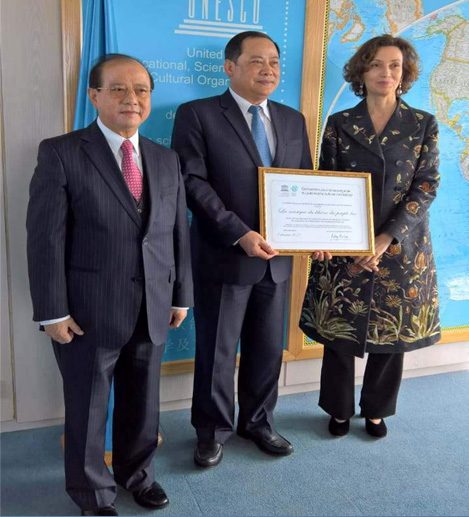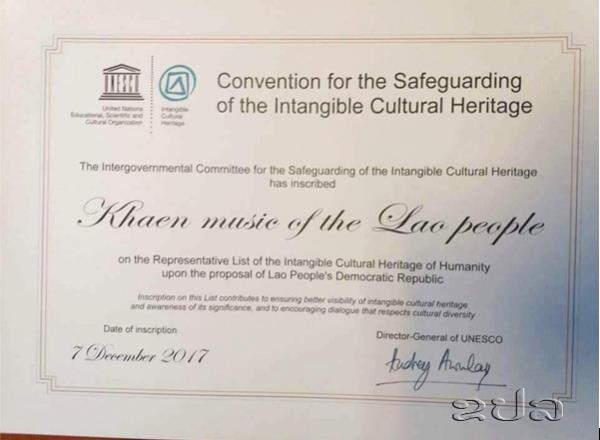KPL
(KPL) Deputy Prime Minister Sonexay Siphandone received on behalf of the government of the Lao PDR the certificate of UNESCO inscription of Khaen Music of the Lao PDR on the UNESCO Representative List of the Intangible Cultural Heritage of Humanity from UNESCO Director General Audrey Azoulay on Thursday.

Deputy Prime Minister Sonexay Siphandone, centre, UNESCO Director General Audrey Azoulay, right and Minister of Information, Culture and Tourism Bosengkham Vongdara at a handover ceremony in Paris, France on Thursday
Sengthong Phasavath
(KPL) Deputy Prime Minister Sonexay Siphandone received on behalf of the government of the Lao PDR the certificate of UNESCO inscription of Khaen Music of the Lao PDR on the UNESCO Representative List of the Intangible Cultural Heritage of Humanity from UNESCO Director General Audrey Azoulay on Thursday.
The handover took place in Paris, France, in the presence of Minister of Information, Culture and Tourism Bosengkham Vongdara.
On Dec 7, 2017, the Intergovernmental Committee for the Safeguarding of the Intangible Cultural Heritage of the UNESCO’s Convention for the Safeguarding of the Intangible Cultural Heritage inscribed Khaen music of the Lao PDR as a World Heritage.
The khaen music of the Lao people is played with a mouth organ that resembles panpipes but made with bamboo tubes of varying lengths, each with a metal reed, according to UNESCO.
The player blows into the instrument through an air chamber and the sound produced depends on the size of the tube.
Khaen music is popular in all regions of the Lao PDR due to its harmonic richness. It is usually part of village festivals and it is customary for people listening to it to become active participants in the songs and dances, rather than merely spectators.
Khaen music is an integral part of Lao life that promotes family and social cohesion. Thanks to the use of bamboo, the practice is also linked to natural agriculture and healthy lifestyles. 
Families play an important role in transmitting the art and khaen player associations exist in many local communities where young people can learn the art.
To maintain the practice in spite of lifestyle changes – including urbanization – several local communities, associations and groups have begun various initiatives to consolidate and promote it through formal and non-formal education.
In 2005, the Association of Khaen Arts was established and various festivals are organized to promote and enhance the art.
KPL